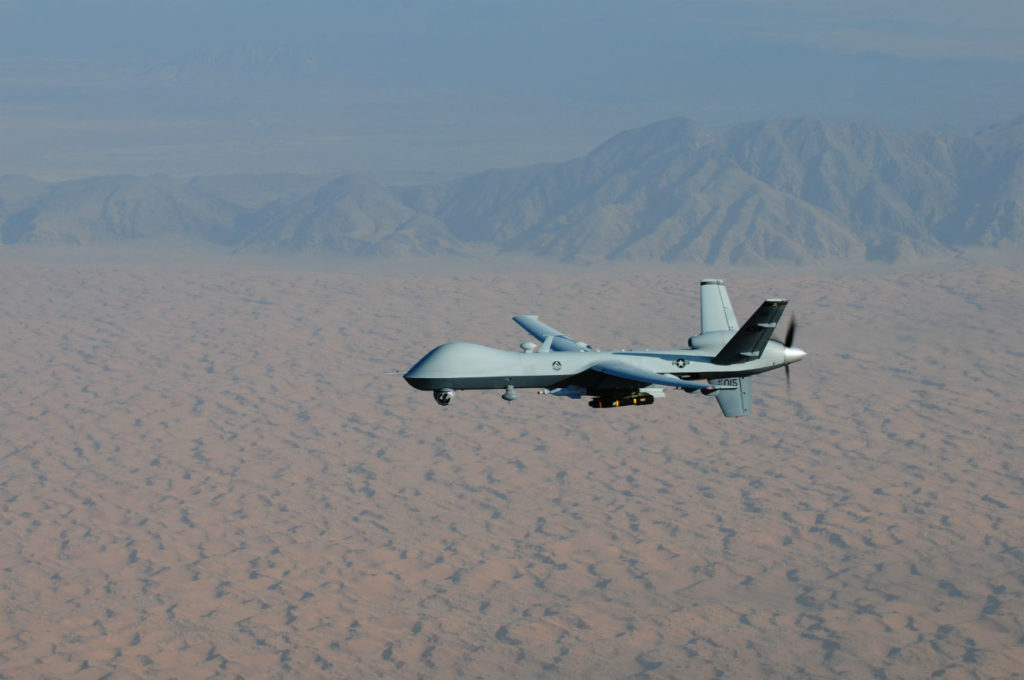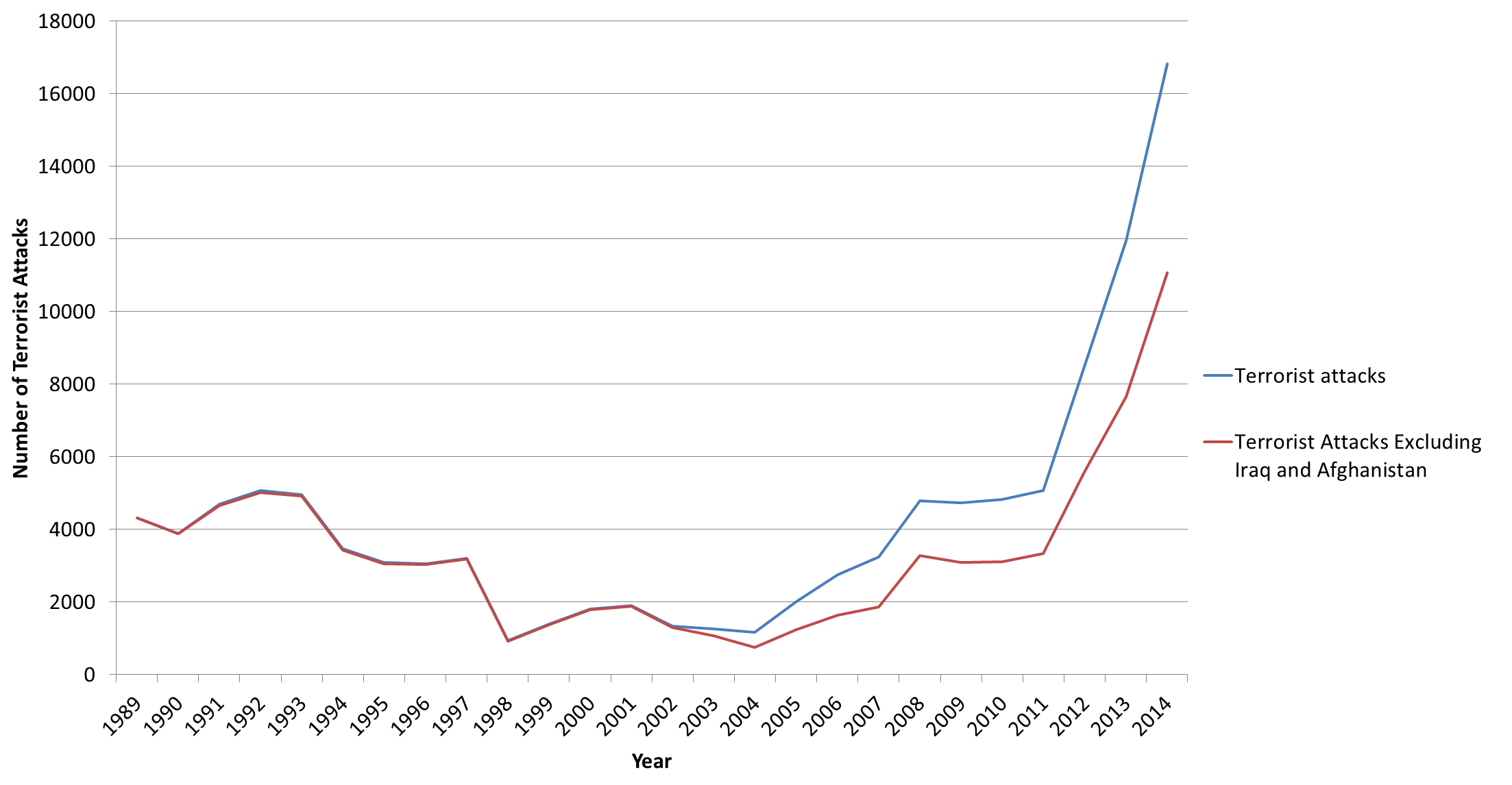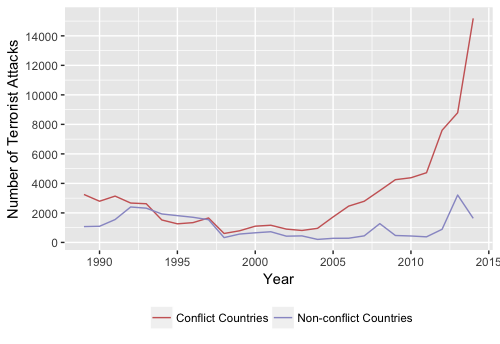Terrorism Before and During the War on Terror: A Look at the Numbers

When a Special Forces mission prompts a U.S. senator to exclaim that he has no fewer than “100 questions” the Pentagon could not answer, you know you have someone’s attention.
In October, four U.S. servicemen were killed in Niger by Islamic militants. The American commandos were part of a clandestine operation to kill or capture an Islamic State operative. The botched raid has prompted a Pentagon investigation, but it has avoided sparking a broader debate about whether the threat posed by terrorism continues to justify the resources, and, more importantly, the attending risk, that the United States commits to it. It is now more than 16 years after 9/11 – long enough to provide a sense of perspective about how the world has changed since the attacks. Policymakers would do well to reexamine the wisdom of characterizing transnational terrorism as an existential threat to international security.
In a recent article, we took a studied look at the number of terrorist attacks before and after 9/11, both inside and outside warzones. The study paired the Global Terrorism Database from the University of Maryland with civil war and insurgency data from the Uppsala Conflict Data Program in 194 countries. Spanning the years 1989 to 2014 allowed us to directly compare terrorist attacks in the early post-Cold War era with those since 2001.

Figure 1
Figure 1 displays the number of terrorist attacks worldwide in the Global Terrorism Database each year from 1989 to 2014. The graphic indicates that global terrorist attacks rose dramatically after 2004: There were just over 1,000 in 2004, but almost 17,000 in 2014. The numbers from 2015 and 2016 (not shown) have remained remarkably high, but below the 2014 peak. The upward pattern holds even when removing attacks in Iraq and Afghanistan.
It is tempting to surmise from the strong trend upwards in Figure 1 that terrorism is on the rise and that the threat is expanding worldwide. The absolute numbers are, after all, higher in the past few years than they were a decade ago. However, this is only part of the story. More than 70 percent of the attacks in the past 10 years transpired in just two regions, both of which have seen extensive insurgency and civil conflict during that time: North Africa/Middle East and South-Central Asia.
It is no secret that most terrorism transpires in the context of insurgency, but to equate the two phenomena is misleading and inaccurate. We therefore wondered, what do the numbers of attacks look like outside of places beset with civil strife? Figure 2 shows terrorist attacks between 1989 and 2014 in countries with and without active civil wars. (A country is designated to be experiencing civil war in any year if violence was ongoing in that year and if at least 1,000 battle-related deaths had taken place there prior to that time.)

Figure 2
A sizable and widening gap between the two curves emerges around 2004, with attacks in countries experiencing conflict starting to far outpace attacks in non-conflict countries. This coincides with expanding wars in Iraq and Afghanistan – and after 2011, turmoil related to the Arab Spring. However, perhaps counterintuitively, the graphic also indicates that for a period in the mid-1990s, terrorist attacks in countries not experiencing civil wars exceeded attacks in war-torn states. Moreover, in some years, the attacks outside of warzones numbered several thousand.
The graphics hint at meaningful differences in terrorist attacks since 9/11, when the “Global War on Terror” began, and the years preceding it. And in fact, our models uncovered meaningful distinctions between the eras.
While terror-related headlines tend to imply the worst, the truth is much more prosaic. Terrorism since 9/11 is down – and dramatically so – in countries not suffering from civil wars and insurgencies. The majority of terror incidents that have taken place during the global war on terror were linked with insurgencies and civil wars. While this was still the case before 2001, the association between terrorism and insurgency has grown significantly stronger during the era of the war on terror.
Relatedly, outside countries afflicted with these forms of political violence, terrorism has been remarkably reduced since 2002. Accounting for the fact that most terrorist activity takes place within the context of active insurgency, the number of terror attacks since 9/11 is significantly lower than between 1989 and 2001. A country not suffering civil conflict was more than 60 percent more likely to experience terrorism prior to or during the year 2001 than since.
The distinction between the eras does not stop here. The analysis also revealed a marked trend reversal in terror attacks (pre- and post-2001) in predominantly Muslim countries. Before 2001, countries with higher Muslim populations experienced less domestic terrorism, while since 9/11, these countries have seen significantly more– both domestic and international. This pattern is particularly strong in places recently afflicted with conflicts, such as Iraq, Afghanistan, Pakistan, Libya, and Sudan.
This finding may be a result of domestic upheavals in parts of the Muslim world and Islamist groups’ involvement in Arab Spring-related conflicts. Islamist insurgencies have risen since 2001 and an increase in terrorism is likely a byproduct of this fact. It is possible that defensive measures in the West have forced a shift in targets. While jihadist terrorism has become more enduring and widespread in the past 15 years, as suggested by the reversal in Muslim-majority countries, it remains more local than global.
Importantly, interventions by Western countries may likewise be contributing to this pattern of terrorism in Muslim countries. Unsurprisingly, we found a positive correlation between Western military interventions on behalf of governments fighting civil wars and domestic terrorism in those countries. The models revealed that Western intervention was associated with anywhere from a two to five-fold increase in the expected number of domestic attacks. No doubt, intervening nations only participate in the most protracted and pernicious wars – those most likely to exhibit terrorism in the first place, suggesting that Western interventions may be a symptom of terrorism in these countries as well as a possible cause. In the past decade and a half, this includes multi-sided insurgencies in countries such as Iraq, Afghanistan, Syria, Libya, and Mali.
What are we to make of these empirical patterns and what are the policy implications?
First, it is possible that post-9/11 counterterrorism efforts have contributed to reducing incidents of non-insurgency terror. In the aftermath of 9/11, the United States and other countries became more diligent in undertaking preventive measures against terrorists, frustrating their plans and degrading their organizations. The data indicate that such labors may have paid dividends in the form of fewer attacks outside of conflict zones, though we are unable to conclusively say this. Moreover, we do not have information on the extent to which counterterrorism efforts have foiled terror plots, which could mean these measures are having an even greater effect than the data show.
Additionally, large deployments of U.S. soldiers in Iraq and Afghanistan also likely provided a richer target environment for jihadists. Those who wanted to kill crusaders could attempt to do so without having to plan and execute much more difficult external operations. This is one of several possible ways in which Western intervention in conflict zones may be linked to higher numbers of terror incidents in those areas.
Second, it is important to point out that the decline in terrorism we describe could be reversed in the next several years. For instance, as foreign fighters return from current warzones such as Iraq and Syria to their countries of origin, attacks may start taking place elsewhere. Foreign fighters may leverage the training and experience they garnered in combat zones to carry out future attacks in their home countries. They may also gain access to Western states and inspire other attackers.
Third, and most importantly, the evidence raises difficult questions about the efficacy of the U.S. approach to the war on terror in the future. Is the United States willing to maintain a sustained presence in Afghanistan, the Middle East, and parts of Africa to confront a problem that is increasingly regional and local? If so, what type of commitment should it maintain and for how long?
The deaths of U.S. service members in remote places such as Niger – where America currently maintains 800 troops – offer a stark reminder of the costs of intervention. As others have pointed out, it is misleading to suggest that “we are fighting them over there so we don’t have to fight them over here.” The fight in Niger—like elsewhere—is not a global one. Certainly, weak and failed states can serve as safe havens for terrorist organizations, as happened prior to 9/11. But the threats they pose are chiefly regional in nature.
Terrorism does not cause civil wars. Rather, terrorists exploit (and often aggravate) these conflicts for their purposes. At a minimum, policymakers should refrain from confusing terrorism – both its causes and consequences – with civil wars. Otherwise, they will continue to treat the symptom and not the cause.
Any debate about a sound U.S. security policy related to countering global terrorism should be informed by the numbers. And the numbers indicate that in as much as there is a concern for combating terrorism internationally, perhaps the focus should be on reducing the incidence of civil war.
Finally, U.S. policy should prioritize combating those international terrorist organizations with the capacity to conduct external operations – that is, those capable of conducting attacks outside the areas in their direct control. Very few terrorist organizations possess the networks and resources to carry out these types of operations.
This issue of prioritization is all the more poignant given that military resources devoted to fighting terrorism abroad take away from those needed to fight a war elsewhere. A Congressional Research Service report estimates that through 2014, the global war on terror cost $1.6 trillion for military operations and supporting efforts. Apart from the actual cost, the fight against violent extremist organizations likely affects the military’s readiness for a fight against a nation-state foe such as North Korea or Iran.
Our investigation casts terrorism and the Global War on Terror in a different light than do some mainstream accounts. Terrorism provokes a pronounced media reaction easily reflected in the headlines, often strengthening the public’s sense of threat. However, a public conception that we live in a totally different world since 9/11, and that the problem of terrorism is worsening everywhere, is as unhelpful as it is inaccurate. If anywhere, such a descriptor applies only to a very limited set of places: countries with high Muslim populations beset by civil war, and particularly those experiencing Western interventions.
Headlines notwithstanding, the world is not awash in terrorism. We are not fighting “World War IV” and equating terrorism with insurgency only overstates its significance and causes unjustified unease in what are otherwise very safe places. Therefore, policies to address terrorism should not be dressed up or justified as counterinsurgency efforts in foreign countries.
Terrorism existed prior to 9/11 and will continue to be a global scourge. Policies aimed at addressing the terrorist threat should be commensurate with that threat and not be confused with counterinsurgency. This is an important first step to achieving a measured and balanced response to terror – not one that exaggerates the threat.
Sean M. Zeigler is an associate political scientist and Meagan Smith is a quantitative analyst at the nonprofit, nonpartisan RAND Corporation.
Image: U.S. Air Force /Leslie Pratt

